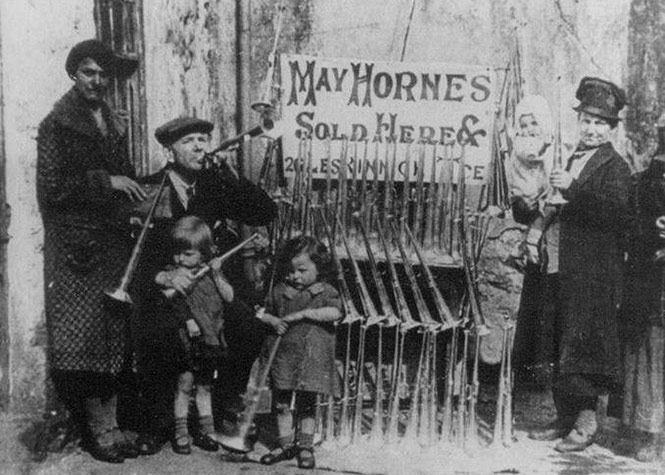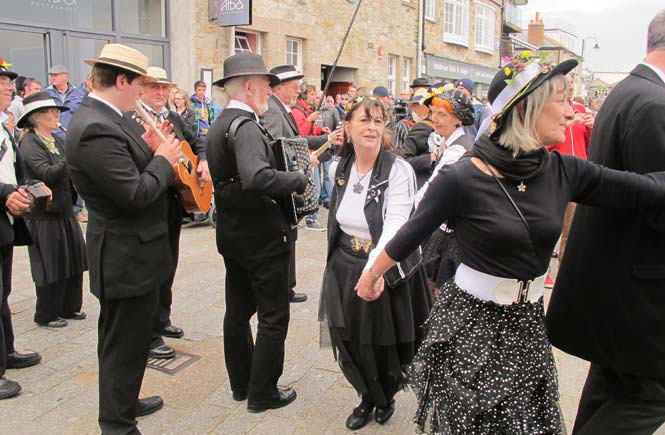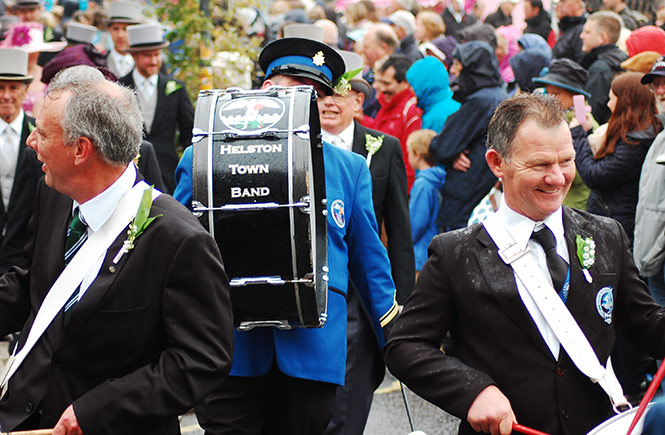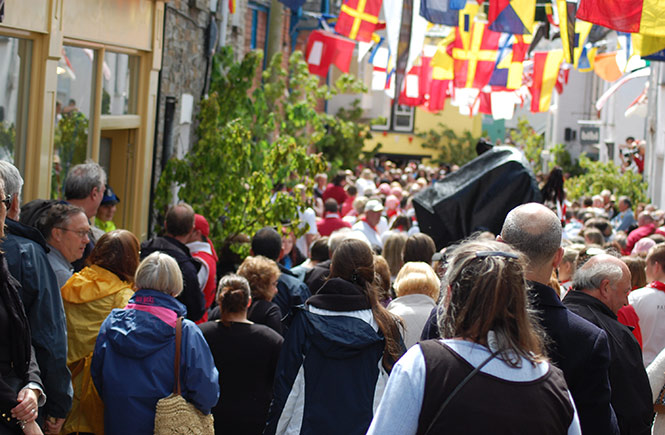Heralding the end of winter and the arrival of spring, May Day is commonly observed throughout Europe and beyond. In north Cornwall the ancient ‘Obby ‘Oss festival in Padstow on May 1st sees the village awash with up to 30,000 revellers, ‘Osses, Teasers and hundreds of accordion players, all singing and dancing summer’s coming. Here in West Cornwall celebrations are slightly less hectic. There’s horn-blowing in Penzance, maypoles and processions in St Ives, and the Furry Dance in Helston on Flora Day.
Penzance
Penzance’s May Horns tradition goes back hundreds of years. On April 30th the townsfolk assembled in the pubs to await the stroke of midnight – the signal for everyone to spill out onto the streets, and blow their tin horns, conch shells and May whistles to drive evil spirits away. At daybreak, they’d go out into the countryside to cut the ‘May’ (hawthorn, blackthorn, sycamore) to decorate the Maypole (no ribbons) with festivities led by the May King and Queen continuing long into the evening.

Banned by the council in 1933 following complaints about the ‘abominable noise’, the tradition was revived seven years ago, and takes place this Sunday May 3rd. Meeting at the Tolcarne Inn in Newlyn at 7.45pm, people dressed in seasonal finery (white or green, with flowers and foliage) will process along the seafront to Penzance blowing horns and whistles and banging drums as loudly as possible. Old Ned, the crow, will ‘die’ three times en route, overcome by ‘the devil of winter’. To revive him everyone must blow their horns and whistles, even louder, until he leaps back to life. Organised by the Cornish Culture Association everyone is welcome, and afterwards there will be music and dancing at the Admiral Benbow.
St Ives

At midday on Bank Holiday Monday May 4th, head to the St Ives Guildhall for the ‘pee whip’ a ceremony where the Mayor and the Grand Bard choose the May Queen and King and their attendant Princess and Prince. Wearing traditional, black and white ‘mock formal’ costumes, be sure to look out for the mysterious, masked St Ives Guisers. Follow the parade down to the harbour at 1pm, to watch the schoolchildren Maypole dancing, and other traditional Cornish dance troupes. May sticks will be brandished and more horns blown, with local choirs and brass bands performing throughout the day. Read more about May Day in St Ives >
Helston

Friday May 8th is Flora Day, and so Helston’s turn to welcome in the spring. Representing vitality and renewal, the town centre is decorated with bluebells, gorse and laurel leaves, which keen volunteers have gathered before dawn. A bass drum strikes the first beat for the morning dance at 7am, where men in shirts and ties, and ladies bravely wearing thin summery dresses, snake their way down the streets, in and out of shops and houses, banishing the dark winter and ushering in the light.

Afterwards, a rowdy mummers play called Hal an Tow, highlights scenes from Helston’s history like the Spanish Armada, St. George and the dragon, and the fight between St Michael and the devil. At 10am it’s the children’s turn to dance, followed by another dance at midday (a very formal affair where frock coats and elaborate ball gowns are essential) with the final one setting off from the Guildhall at 5pm.
Food stalls and local cafes will ensure you don’t go hungry, or you can pack a picnic and stroll down to the boating lake, where there’s a great play park for the kiddies, and fairground rides. All the pubs do a roaring trade with lots of live music and pints of the infamous local tipple, Spingo. Meaning ‘strong ale’ in Old English, and only brewed at the Blue Anchor Inn in Coinagehall Street, it is indeed, strong.
So if you fancy some Cornish May Day fun and games, dig out your dancing shoes and noisy horns and join in the celebrations. But be warned, it’s not just the Spingo that’s potent round these parts. May Day’s pagan roots saw it celebrated as a fertility festival, and as a gentleman noted in 1851, “I have known ten maidens go out Maying, and nine to come back with child.”
